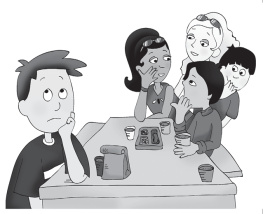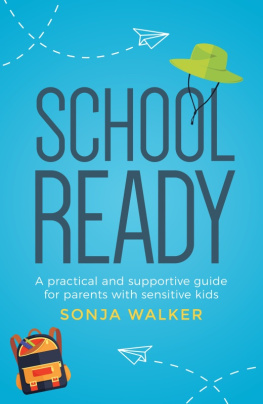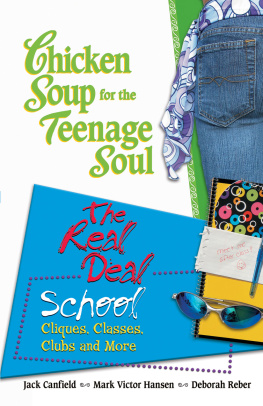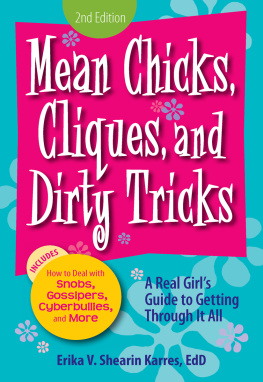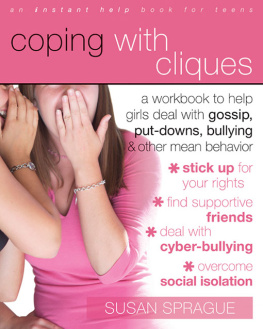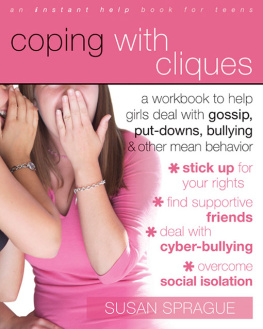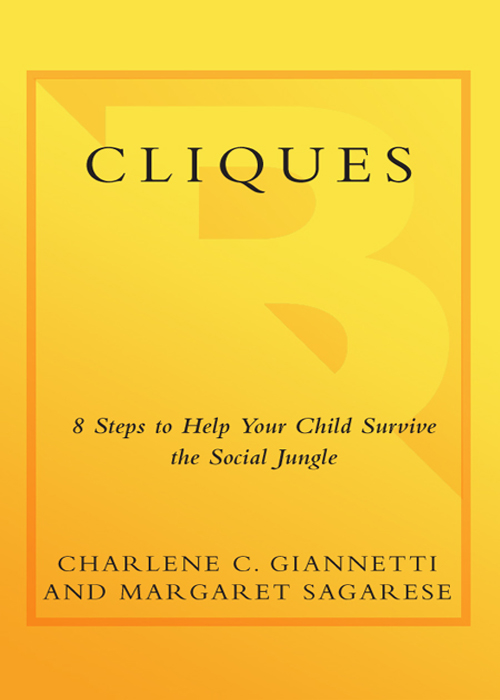
CLIQUES
8 STEPS TO HELP YOUR CHILD
SURVIVE THE SOCIAL JUNGLE
CHARLENE C. GIANNETTI AND MARGARET SAGARESE
BROADWAY BOOKS
NEW YORK
CONTENTS
STEP SIX
Teach Your Child Tolerance
T he climate of cruelty in our schools is based on intolerance for others. Children are singled out for their differences because those variations are viewed as weaknesses. But if we can teach our children to be open-minded, they will be less inclined to use cliques to torment others.
Remember the classic childrens story The Fox and the Hound? The message of the tale was a simple one for children to grasp: Differences dont have to stand in the way of friendship. In fact, they can be the saving grace. The fox and the hound had fun playing together when they were small. Later, the outside world intruded, insisting that opposites cant be friends. The two found it challenging to continue their friendship, but they persevered. The value of that perseverance and loyalty paid off when the hound came to the foxs rescue, saving his life.
And so it happens with our children, too. They start out, in their innocence, accepting others, regardless of their differences or limitations. Soon, however, they begin to understand that not everyone is alike. Just looking around their classrooms, they can see the differences for themselves. Their classmates come in all sizes, shapes, and colors. Some are athletic, others maneuver through the day in wheelchairs or using crutches. They practice various religions and not all have English as their native language. While some children live in two-parent homes, others are being raised by a single mother or father, grandparents, or a gay couple. Students whose clothes sport the latest designer logos sit next to children whose wardrobes consist of worn hand-me-downs.
Americas classrooms are a microcosm of our society. We are a diverse people and grow more so each day. What our children are now experiencing in school is just the beginning. As they move through college, into the workplace, enter relationships, and settle into neighborhoods, learning to accept and embrace the differences of others will be essential to their success.
Tolerance for others will also serve our children well during their time in middle school. In this chapter, we will:
Explain the role intolerance plays in cliques.
Deliver a wake-up call so that you can examine your own prejudices.
Give you ways to teach your child to be accepting of other peoples differences.
Get to the root of prejudiceshow our children learn to hate.
Warning: What follows may be painful for you to hear. We cannot teach our children to be magnanimous unless we are first honest about our own prejudices. Remember that middlers are quick to home in on our hypocrisies. If we preach acceptance while we practice rejection, the difference will be all too obvious.
CliquesBirds of a Feather
In the movie Grease, the Pink Ladies attempted to change Sandys squeaky-clean looks so that she would fit into their edgier group. Not much has changed since the 1950s, the decade in which the movie was set. Kids still flock to those whose attitude and appearance coincides with their own. Anything that makes someone stand out will not only make it difficult for that child to be accepted, but may also make the child the target of ridicule, even violence.
In order to understand the dynamics at work here, you have to go back to our earlier book, The Roller-Coaster Years, and review what we said about young adolescent development. Children from ages ten to fifteen are walking bundles of insecurity. They suffer from appearance anxiety, obsessing about their facial features, body parts, and clothes.
All middler insultsThats so gay, being the major oneare about differences. Cliques are based on the safety of similarities. Those who are different are shunned.
When we tolerate others we respect their differences and allow them to be themselves, free of our criticism, disdain, or abuse. In middle school, with so many children attempting to hide their blemishes, there is little room for embracing the shortcomings of others. Posters hanging on classroom walls may proclaim, CELEBRATE DIFFERENCES ! In actuality, CONCEAL DIFFERENCES ! might better represent what happens.
Of course, many differences cant be hidden. A childs skin color, ethnic origin, disability, or economic status is often apparent to everyone. Our files are filled with magazine and newspaper articles and comments from parents and children who talk to us in person or on-line about the torment that greets those who refuse or are unable to adapt. Heres a sampling:
Melissa Pages, then a senior at a Ft. Lauderdale, Florida, high school, revealed she was gay by flying a rainbow flag during a homecoming parade. People screamed, Fags go home, threw things from the bleachers, and spit on her. These were people that I had loved, she said, in the April 1999 issue of Seventeen magazine. The school was my second home, and people were spitting on me. Rather than reprimand those who harassed Pages, the schools principal advised her to lay low about her homosexuality.
In Amarillo, Texas, in 1999, athletes from the high school targeted the towns punks, who had spiked hair and pierced body parts. One jock hopped in his Cadillac and deliberately ran down a punk. He drove home with his stunned girlfriend sitting in the passenger seat. An Amarillo jury sentenced the hit-and-run murderer to probation. The defense attorneys had played on the publics disdain for the punks anti-social image. The victim was seen not as a scared boy running from an oncoming car, but as a hostile enemy of the state of Texas. Prejudice prevailed. The dead boys parents suffered two shockstheir sons death and the animosity from their conservative community.
One mother came onto our site at Parent Soup to tell us, My son is overweight and very self-conscious. The kids dont help. They ignore him. He has no friends. He has a fifty-minute bus ride in the morning and no one will sit with him or talk with him. He spends his entire day by himself. He feels anonymous. No one knows his name or cares what he thinks.
After a talk we gave in a middle school, a sixth-grade girl approached us with this: Im teased every day because Im adopted. How can I get them to stop? Im not any different than the other kids.
At a booksigning in Denver, Colorado, a mother asked us: My daughter, twelve, has a physical disability. Her girlfriends used to be fine with it. Now that they are all interested in boys, I notice she is not being included in any of their movie plans or parties. She is so hurt. What can I do to help her?
One father intercepted his sons e-mail: Kids from the outcast world join up for a reason, to make a statement. Its to show that even though we may have been rejected by some, we have not been rejected by everybody! If you cant be proud of being a jock or a brain or whatever, then you can be proud of being one of the outcasts! Did his sons call to arms presage violence? How can we forget that the Columbine shooters viewed themselves as outcasts, too?
When parents such as the ones above ask us for advice, we give them ways to work with their children, helping them to reach out to others, to align themselves with those who are isolated, and perhaps to find a support group, if appropriate. Real change, however, wont occur until all parents recognize how intolerance harms all our children. There are many others out there eager to teach our children to hate. We need to step forward to teach our children to include others. The need is critical.
Next page

